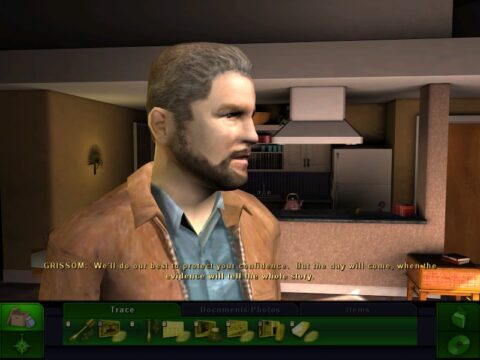
CSI: 3 Dimensions of Murder
Written by: Rik
Date posted: May 22, 2011
- Genre: Adventure
- Developed by: Telltale Games
- Published by: Ubisoft
- Year released: 2006
- Our score: 5
The level of quality within my DVD collection is variable: there’s enough crap in there to seriously trouble anyone with even the vaguest designs on being a film or TV snob (who would doubtless immediately reel of a list of omissions or superior titles), without there being enough for me to try and pass myself off as some kind of B-movie fan or humorous/ironic interpreter of blockbusters and/or trashy TV.
Frankly, I’ll pretty much watch anything, which might be considered a good thing in that it suggests a laid-back, happy-go-lucky personality, content with taking most entertainment at face value without expending time and effort being disappointed about some or other aspect of it.
Unfortunately, though, the opposite is true. In fact, being easily entertained can be a bit of a problem, especially if you combine it with the kind of obsessive personality that needs to follow up this kind of superficial enjoyment with a bizarre and intensive quest to ensure that ALL OF THE FILMS or ALL OF THE SEASONS are viewed as quickly as possible, while also conducting detailed internet searches for related trivia so that eventually you know more about the thing you once found moderately enjoyable than you ever expected to.
You’ve got the knowledge, but not the genuine enthusiasm, of a hardcore fan, but somehow you’ve manoeuvred yourself into a position where, in conversation with normal, sane people, you either have to pretend you have high regard for something you actually only ever found mildly diverting (“CSI? Oh yeah, it’s my favourite TV show”) or deny that you actually like it very much at all despite overwhelming evidence to the contrary (“Yeah, I mean, I spent £80 on box sets, and I’ve got all the games, and I keep mentioning it in conversation, but I’m not really a fan”). Of course, the first option is easier. And if I’d taken that one, we’d be into the review already.
Anyway, that’s why we’ve got yet another CSI game here for you on FFG, and a comparatively recent one at that, while mountains of more worthy retro and budget releases continue to be ignored. I’m sorry. I can’t help it. But there will be no more, after this.
So, here we have CSI: 3 Dimensions of Murder, a title which implies significant technological progress for the series, and with the developer’s baton being passed from the unheard-of 369 Interactive to the much-loved modern-day stalwart of adventure games, Telltale, early signs for the game seem promising. Once you get into the game, though, it soon becomes apparent that although there are noticeable improvements throughout, CSI: 3DM largely sticks to the design and format of the earlier games in the series, which means it delivers a broadly similar experience.
(For the record, by the way, I’m ignoring 2004’s CSI: Miami, for two reasons: 1) it’s based on the TV show, CSI: Miami and 2) it was developed by 369 Interactive – so I’m doubly-sure I wouldn’t enjoy it). [Edit: Stoo subsequently gave it the once-over, however.]
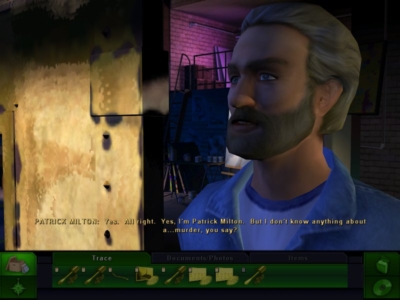
Rules of CSI #542: When someone says they don’t know anything about a murder, it usually turns out that they do know quite a lot about it.
Let’s start with the graphics, which finally make use of polygon models, texture mapping and all of that other stuff that most other games have been using since 1998. It’s this change that’s presumably the basis of the ‘3 Dimensions’ reference in the title, although if you were imagining a world where you’d be free to roam around a crime scene and investigate, you’ll be disappointed to find that this isn’t the case. Essentially, it’s the same format as before – you arrive at a scene, search for hotspots, and then if you find one and click on it, the game moves you in for a closer look.
The one area in which the upgraded engine brings practical improvement is when you come to examine evidence as items can be flipped and rotated as you search for trace or fingerprint evidence. Elsewhere, the results are superficially pleasing: characters seem ‘alive’ and much more dynamic than before (thanks in no small part to the fact that they now move parts of their body other than their mouth), especially in conversation, where you can even detect changes in expression depending on the mood of the character, which is a nice touch. The polygon versions of your CSI colleagues are generally an improvement on the ghoulish, dead-eyed appearance of the cast in previous games, although some look more realistic than others (Grissom and Warrick, in particular, look alarmingly like cuddly-toy versions of themselves).
As I mentioned earlier, the structure of the game hasn’t changed massively – and by that I don’t just mean that you start by going to a crime scene to collect evidence, process it at the lab and then build a case against a suspect (because it’s hard to imagine how else a game based on the show could be set up, after all). There’s a definite sense of Telltale following the template of previous games – particularly in the little details, such as keeping the same navigation toolbar at the bottom of the screen – when you might have expected them to try and put their own stamp on it a little more.
That isn’t to say that nothing’s changed, though, and you do notice things here and there. Lab work, in particular, is more interactive – if not more challenging – than before, and with Sanders’ promotion to CSI, you no longer go running to him with all of your evidence; you have to do all the lab work yourself. The equipment at your disposal is more varied, too – while previously you either looked at evidence under the microscope or accessed lab analysis results on a generic, all-knowing, multi-functional computer, this time you actually have chemical analysis and DNA machines with which to do your own processing. You also get a table (woo!), on which you can perform tasks such as taking the clip out of a gun and assembling documents that have been ripped into a handful of very large pieces (double-woo!).
It’s certainly better than before, although in practice, the change makes little difference to this section of the game (analysis is still a very simple clicking and dropping process with very little thought required). Given that the show is meant to be vaguely science-y, I can’t help but think this is an area that could have been developed a little more – I mean, I don’t actually want to have to learn any science, but I wouldn’t be averse to the odd mini-game or even (heaven forbid) some QTEs to make it feel a bit more like I was actually doing something in the lab – at the moment, you shove evidence into a machine like a ready-meal into a microwave.
While the general setup remains familiar, there are noticeable improvements in other areas. Most significantly, the cases themselves are better structured and easier to follow than before – with the ‘Evidence Trinity’ screen for once giving you an idea of what’s needed to get a warrant or bring in a suspect. The stories are better, too, and you actually have a sense of wanting to find out who the killer is.
That’s pretty much the main thing you want when you play a CSI game, although other, more superficial, details can help deliver an added sense of authenticity. The improved graphics are certainly a plus, but elsewhere more fussy fans might still find the game lacking. Voices remain a mixed bag – some characters are voiced by the real actors and some by stand-ins this time around, but at times you find it difficult to tell which ones are which. That’s kind of a compliment to the replacements, but also tells you something about the performances of the rest – some of whom really don’t sound like themselves.
On the same topic, I should report that opening credits are still absent – which means, by extension, no Who Are You?. Grainy video clips of Las Vegas at night are still employed but seem out of place with the clean-and-colourful visual style of the rest of the game. There also remains very little interaction with your partner, or other colleagues at the lab, during the course of your investigations, although there are occasional mid-case interludes, which involve suddenly finding yourself in a room with Grissom and Willows discussing your progress on the case so far and what you might need to do next. It’s a nice idea, but badly implemented: these scenes seem to cut into your game very unexpectedly (sometimes even the game itself doesn’t expect it and promptly crashes), the dialogue seems forced, and you find yourself just wanting it to end so you can get on with the game. It is possible to include this kind of thing and do it right – in fact, I know that it is, but I don’t want to start banging on about the bloody DS version again.
Numerous other small annoyances and flaws have been carried over from previous efforts, and although improvement in other areas means that you’re less likely to notice them, they’re worth at least a passing mention. Firstly, on several occasions you search a house or other location with the owner or associated suspect in attendance, find incriminating evidence, and then talk about it in detail at the scene, as if he or she wasn’t there (a bit nit-picky, this one, perhaps). Secondly, when you go to the morgue, you might ask Dr. Robbins a question about, say, a victim’s blood alcohol level and he’ll reply that you need to check back later. In this case ‘later’ means immediately after him answering that question, and he can give you the results without you even having left the room. Finally, interrogations continue to be poorly implemented, with one particular annoyance repeated for the third time in as many games and hence worthy of a separate side-feature all of its own (see She’s on her way to interrogation now). But also: why is there never any pressure on you to ‘break’ a suspect by presenting evidence? And why do none of these people ever hire a lawyer?
All-in-all, then, CSI: 3 Dimensions of Murder is a more-than-passable attempt to bring an interactive version of the hit TV show to our PC screens. It’s a marked improvement on previous efforts without necessarily being as good as it could be. If you were naturally of a cynical persuasion you might be of the opinion that developers Telltale phoned this in for easy money while concentrating their creative efforts on Sam and Max and other, more ‘worthy’, franchises – and while you can hardly blame them for doing so, it still seems like a bit of a waste of a good license. Especially if, you know, you’re a fan of the show. Which I’m totally not, by the way.

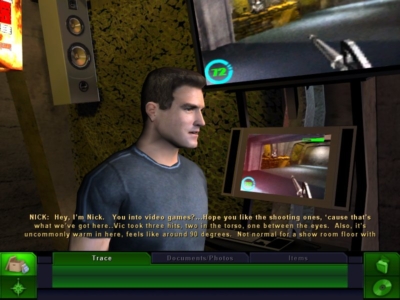
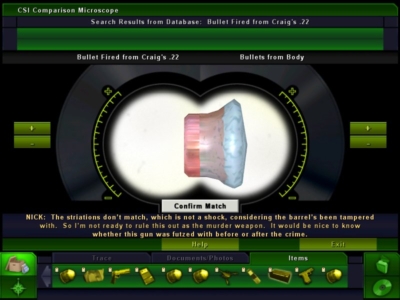
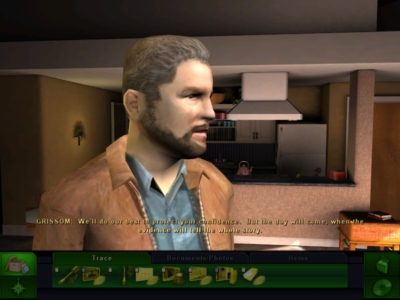

 Posts
Posts